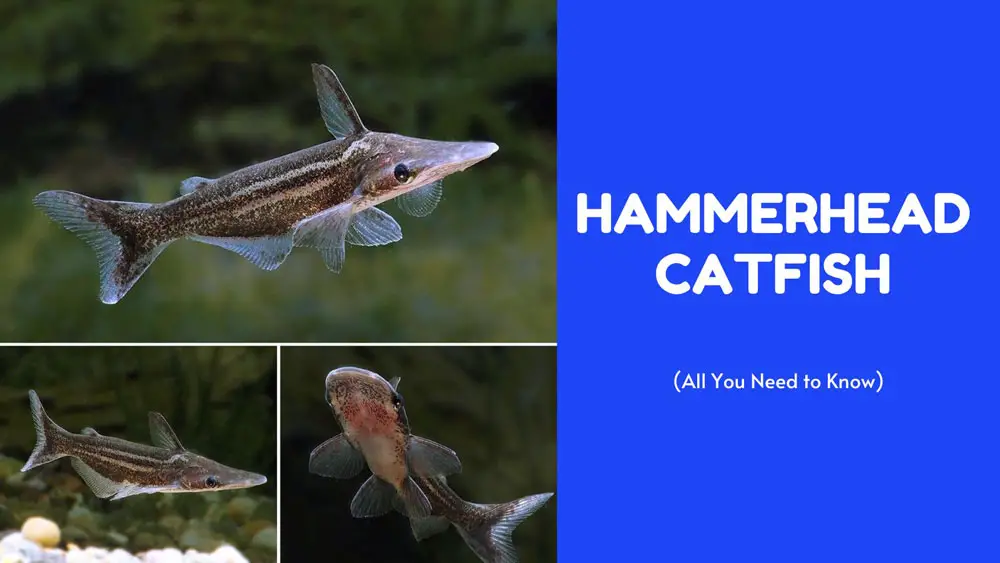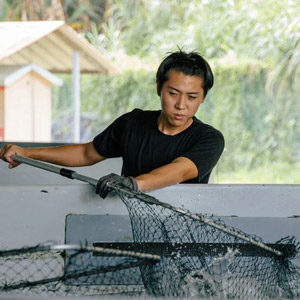Sometimes known as Bottlenose catfish or dolphin catfish, the Hammerhead Catfish, as you might expect from such a descriptive and fascinating name, have a head that is large and flat and is shaped, unsurprisingly, like a hammer.
There are a few different species from the genus Ageneiosus that go by this common name, with A. marmoratus being the most widely available. It is also worth noting that A. marmoratus has been recently considered a junior synonym of A. inermis.[1]
These unusual catfishes were only recently revised but have been in the hobby for some time as they are interesting and attractive fish.
Without further ado, let’s find out a bit more about these peaceful and good-looking cats.
Species Summary
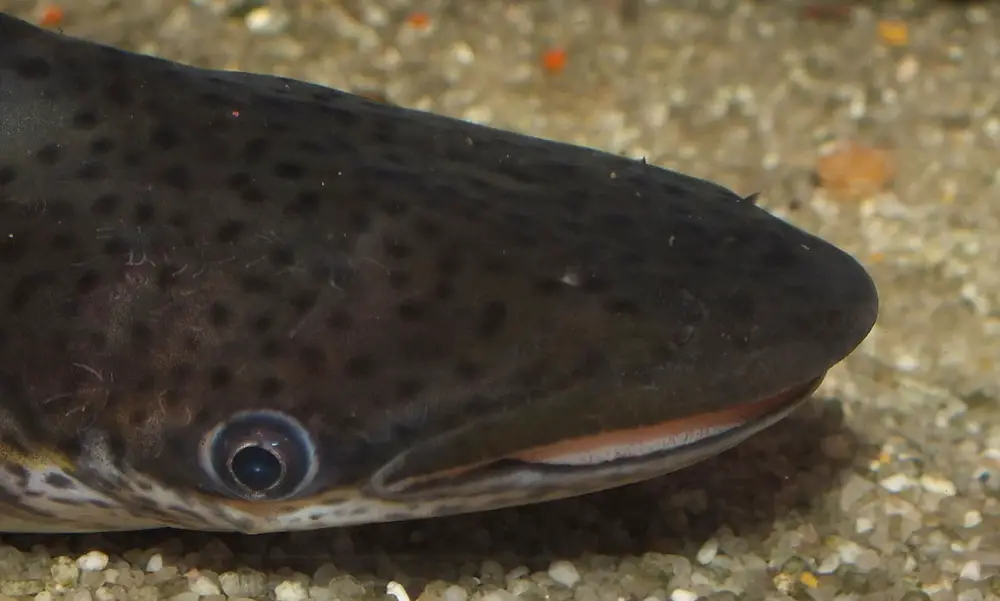
Ageneiosus is a small group of driftwood catfish (or wood cats) found mostly throughout South America. It includes 13 scientifically described species, only of two of which are available in the aquarium hobby: A marmoratus (Jaguar Dolphin Cat) and A. magoi (Orinoco Dolphin Cat); the latter is not seen in the trade very often.
Thanks to their small full-grown size, they can make a suitable addition to many freshwater community tanks. However, they are somewhat less popular catfish because of their high price tag.
Driftwood catfishes are nocturnal, meaning they will be active and come out to feed during the night and hide in logs and caves during the day.
The species of the Auchenipteridae family have a unique evolutionary reproduction process that involves internal fertilization. Males develop a modified anal fin that serves as a copulatory organ, allowing for the fertilization of eggs inside the female. This process is similar to that of livebearers, such as guppies and mollies.
Colors and Markings
Hammerhead catfish or dolphin catfish (Ageneiosus spp.) are aptly named for their hammer-shaped heads, wide mouths with lips, and elongated bodies.
The bodies of hammerhead catfish are typically dull in coloration, as seen in the Jaguar Dolphin Cat (A. marmoratus), with black blotches of various sizes serving as camouflage in their natural habitat. On the other hand, the Orinoco Dolphin Cat (A. magoi) boasts a yellowish hue and distinctive broken stripes, making it a visually appealing species in an aquarium setting. Unfortunately, these black marble markings mostly fade as the fish matures.
Many other members of the Ageneiosus genus are also commercially valuable and often prized by experienced fish keepers. Identifying young individuals can be challenging, as their distinctive features may not yet be fully developed. If you are lucky enough to come across one of these species and are looking for traits to verify its identity, here is what you should look for:
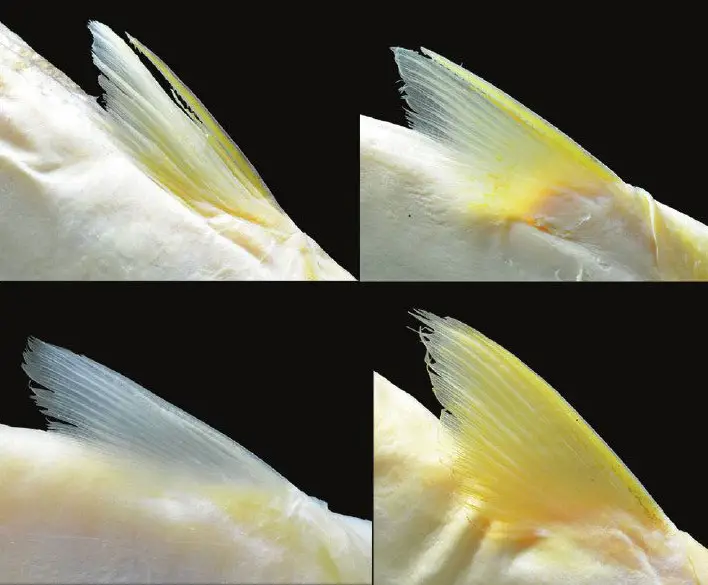
| Species | Standard length (SL) |
|---|---|
| A. akamai | Anal fin: (31 -) 34 (- 37) soft rays Caudal fin: 17 soft rays | deeply forked | top and bottom approximately the same length Dorsal fin: I / 6 rays Pectoral fins: (11 -) 12 (- 13) soft rays Pelvic fins: 6 soft rays |
| A. apiaka | Anal fin: (40 -) 42 soft rays Caudal fin: 17 soft rays | deeply forked | little longer at the top than at the bottom Dorsal fin: I / 6 rays Pectoral fins: 12 (- 14) soft rays Pelvic fins: 6 soft rays |
| A. dentatus | Anal fin: (40 -) 44 (- 49) soft rays Caudal fin: 17 soft rays | deeply forked | little longer at the top than at the bottom Dorsal fin: I / 6 rays Pectoral fins: (11 -) 13 (- 15) soft rays Pelvic fins: 6 soft rays |
| A. intrusus | Anal fin: (37 -) 46 soft rays Caudal fin: 17 soft rays | deeply forked| having a dark band on the outer edge Dorsal fin: I / 6 rays Pectoral fins: 13 (- 16) soft rays Pelvic fins: 6 soft rays |
| A. lineatus | Anal fin: (32 -) 34 – 35 (- 38) soft rays Caudal fin: 17 soft rays | deeply forked| having prominent dark stripes Dorsal fin: I / 6 rays Pectoral fins: (12 -) 13 (- 15) soft rays Pelvic fins: 6 soft rays |
| A. magoi | Adipose fin: present Anal fin: iv – v / 29 – 35 rays Caudal fin: 8 + 9 soft rays | straight to convex Dorsal fin: I / 6 rays Pectoral fins: (11 -) 12 (- 13) soft rays Pelvic fins: 6 soft rays |
| A. militaris | Adipose fin: present Anal fin: iv – v / 29 – 35 rays Caudal fin: 8 + 9 soft rays | deeply forked, symmetric | straight, pointed Dorsal fin: I / 6 rays Pectoral fins: (12 -) 13 (- 14) soft rays Pelvic fins: 6 soft rays |
| A. pardalis | Anal fin: (35 -) 38 – 39 (- 43) soft rays Dorsal fin: I / 6 rays Pectoral fins: 13 soft rays Pelvic fins: 6 soft rays |
| A. polystictus | Adipose fin: present Anal fin: iv – vi / (26 -) 31 – 32 (- 33) rays Caudal fin: 17 + 8 (- 9) soft rays forked / concave, round Dorsal fin: I / 6 rays | straight Pectoral fins: 13 – 15 soft rays Pelvic fins: 7 soft rays |
| A. ucayalensis | Adipose fin: present Anal fin: v – vi / 34 – 42 rays Caudal fin: 8 + 9 soft rays | deeply forked / concave, pointed Dorsal fin: I / 6 rays Pectoral fins: (12 -) 14 (- 15) soft rays Pelvic fins: 6 soft rays |
| A. uranophthalmus | Adipose fin: present (may rudimentary) Anal fin: IV – V / (37 -) 43 (- 45) rays Caudal fin: 17 soft rays | deeply forked | concave, pointed | little longer at the bottom than at the top Dorsal fin: I / 5 rays Pectoral fins: 12 – 13 soft rays Pelvic fins: 6 soft rays |
| A. vittatus | Adipose fin: present Anal fin: iv – v / (30 -) 32 – 35 rays Caudal fin: 8 + 9 soft rays | slightly forked | concave, pointed Dorsal fin: I / 6 rays Pectoral fins: 12 (- 13) soft rays Pelvic fins: 6 soft rays |
Lifespan
Hammerhead catfish can be kept in an aquarium and survive in captivity for 10 years, around 15 years in some cases. This is much longer than their predicted survival in the wild which would be shortened due to being prey to larger fish and changing climates.
Hammerhead Catfish Size
Selecting the right species is crucial when it comes to keeping a catfish. Some start small but can reach impressive sizes; the common pleco (Hypostomus plecostomus) is a good case in point.
Hammerhead catfishes, luckily, are of relatively small size, making them ideal for aquariums. But a few are capable of growing to an enormous length of almost two feet and are better suited for outdoor ponds.
| Species | Standard length (SL) |
|---|---|
| Ageneiosus akamai | 6.9 inches (17.4 cm) |
| Ageneiosus apiaka | 8.0 inches (20.3 cm) |
| Ageneiosus dentatus | 9.8 inches (24.8 cm) |
| Ageneiosus intrusus | 11.0 inches (28.0 cm) |
| Ageneiosus lineatus | 6.3 inches (16.0 cm) |
| Ageneiosus magoi | 6.8 inches (17.2 cm) |
| Ageneiosus militaris | 11.8 inches (30.0 cm) |
| Ageneiosus pardalis | 16.9 inches (43 cm) |
| Ageneiosus polystictus | 16.9 inches (43 cm) |
| Ageneiosus ucayalensis | 12.2 inches (31cm) |
| Ageneiosus uranophthalmus | 9.1 inches (23 cm) |
| Ageneiosus vittatus | 8.1 inches (21.3 cm) |
| Ageneiosus marmoratus | 7.3 inches (18.5 cm) |
Habitat and Care
Hammerhead cats are very hardy and easy to keep. The most important part of their care is providing a suitable, quiet, daytime resting place since these nocturnal bottom dwellers are somewhat loners and shy, preferring their own company in a dimly lit or darkened area.
Since most Ageneiosus specimens sold now are wild-caught, causing them more prone to be stressed from improper water parameters, and may be picky with commercial dry food, so be patient and persistent.
Hammerhead Catfish Tank Size & Growth Rate
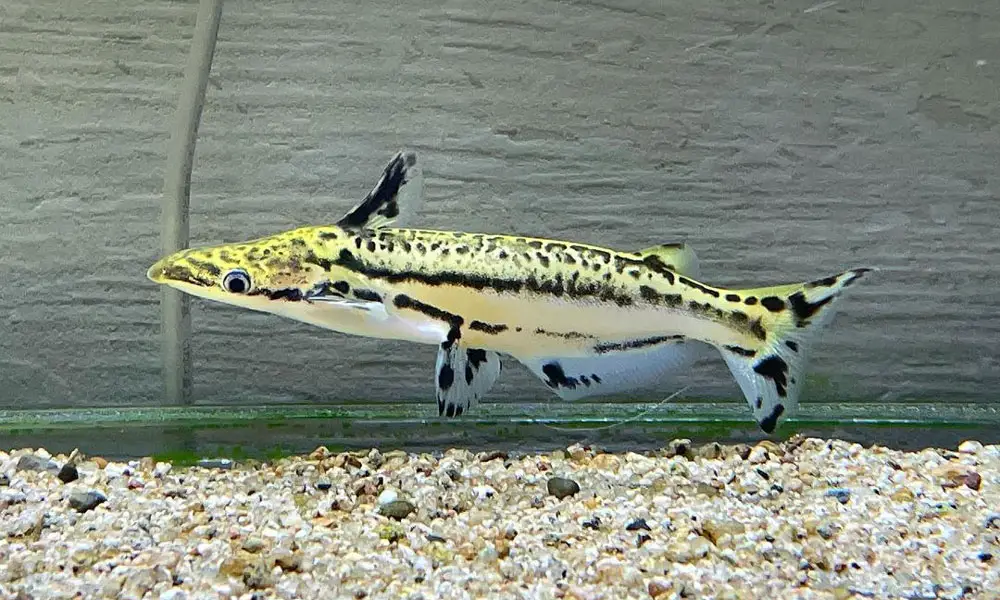
It depends on which species you are keeping. Keep in mind a fully grown A. inermis can reach 23 inches (59 cm) in length. So, be sure to verify the species before making any decisions.
Ageneiosus are slow to moderate growers; I’d say they have a steady growth rate. The last A. marmoratus I got was about 2 inches from a local dealer, and I got it to 9 inches in 6 months.
Water Parameters
Ageneiosus can be found in diverse habitats ranging from white water to black water. The water temperature is not a crucial factor, however, it’s recommended to have moderately soft water with a slightly acidic to neutral pH.
Try to mimic the conditions from their natural habits to give your hammerhead a better chance of thriving.
As they are predatory species, these cats require a well-oxygenated environment, so it’s important to consider the tank size and filtration system. Make sure to use an efficient aquarium filter that can provide a high water turnover rate.
Like any other catfish, they are susceptible to poor water conditions. A weekly 30-50% water change is recommended to prevent the occurrence of diseases.
Decor
Naturally, their favorite levels are at the bottom, frequenting woody and sandy areas. A soft sandy substrate is preferred though it is not essential. However, hiding spots created by plenty of driftwood, roots, plants, and caves are a must, especially with other nocturnal species or bottom feeders.
Care should be taken not to overcrowd the tank with such items as lots of room is required for swimming and exploring its habitat. They are good swimming cats and cruise around a lot!
Not only does driftwood make suitable shelter, but it also acts as a substrate on which they can feed on biofilm and algae.
Similarly, dried oak leaves are a good choice for Hammerhead cat care as they provide hiding spots, release tannins to lower the pH level, aid the development of fish fry by promoting the tank’s fauna growth, and add a nice natural touch to the tank.
Due to their nocturnal behavior, dim lighting is necessary. To observe their nighttime activities, a moonlight lighting fixture can be used.
Diet and Feeding
Speaking of diet, larger Ageneiosus differ from other members of the catfish in that small fishes and invertebrates make up most of their natural diet.
As obligate carnivores, it’s crucial to offer a variety of live foods for hammerhead catfishes, including feeder guppies and goldfish, beef heart, shrimp, and chicken. This will ensure that they receive the proper nutrition they need.
Newly acquired aquarium fish can be weaned off of a prepared diet consisting of frozen aquarium food, such as whitebait, brine shrimp, or shellfish. Some individuals will adapt to carnivore fish food, but it takes time.
In the past, I had problems finding live food. I never found my marmoratus to be interested in pellets (Hikari sinking carnivore pellets) or even earthworms and daphnia. The only thing that worked was feeder fish.
On a side note, feeder fish may carry diseases or parasites. It’s crucial to quarantine them before introducing them to your aquarium to avoid any potential health risks to your fish or other aquatic inhabitants.
Bear in mind that these species are active at night, so it’s best to feed them in the aquarium during the night when the lights are turned off.
Behavior and Tank Mates
Hammerhead catfish are fairly peaceful cats, but only when they are not in mating season – during mating season is the time in which they may become naturally more aggressive.
They may be territorial, so care must be taken to house only with calm tank buddies of a similar temperament and size. Any smaller fish that can fit in their large mouths may be seen as potential prey and should not be kept in the same tank.
As far as tank mates go, I’d suggest keeping them with other small South American cichlids.
Breeding
Attempting to breed the Hammerhead Catfish in an aquarium can be difficult, bordering upon almost impossible, but with the right equipment and environment, it can be done.
Males Vs. Females
Ageneiosus species do not have any distinct external features until they are ready to breed.
During the breeding season, males tend to have large, rigid dorsal spines and develop a long barbel that can extend past their anterior eye when pressed against the side of their head.
After the breeding season, these two sex characteristics become less pronounced, making it nearly impossible to differentiate between the sexes.
Spawning
Unfortunately, no reliable sources indicate that Ageneiosus species have been successfully bred in home aquariums; however, reproduction is presumably similar to that of other family members.
Closing Thoughts
Hammerhead catfish are more uncommon and expensive fish in the aquarium hobby, so finding them in a store may be a challenge. Sometimes, they may pop up in fish-keeping communities, but usually, you’d have to order them from online shops.
If you are lucky enough to get one, these cats provide a nice addition to the aquarium with their unique shapes and breeding behaviors as long as you have a realistic understanding of their requirements.
If you happen to have any questions about one of these cats, particularly A. marmoratus, let me know!
